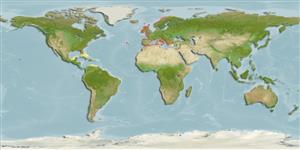Common names from other countries
Classification / Names / Names
Common names | Synonyms | Catalog of Fishes (gen., sp.) | ITIS | CoL | WoRMS
Environment: milieu / climate zone / depth range / distribution range
Ecology
Benthic; depth range 0 - 4 m (Ref. 2059). Temperate
Atlantic Ocean, Mediterranean and Western Indian Ocean. Tropical to subtropical.
Length at first maturity / Size / Weight / Age
Maturity: Lm ? range ? - ? cm Max length : 0.0 cm TL male/unsexed; (Ref. 2105)
Minimum depth from Ref. 111259.
Todaro, M.A., M. Balsamo and P. Tongiorgi. 2002. (Ref. 2059)
IUCN Red List Status (Ref. 130435: Version 2024-1)
CITES status (Ref. 108899)
Not Evaluated
Not Evaluated
Human uses
| FishSource |
Tools
More information
Common namesSynonymsPredatorsReproductionMaturitySpawningFecundityEggsEgg development
Age/Size
Growth
Length-weight
Length-length
Morphology
Larvae
Abundance
Internet sources
Estimates based on models
Preferred temperature
(Ref.
115969): 9.5 - 26.9, mean 19.1 (based on 1149 cells).
Vulnerability
Low vulnerability (10 of 100).
Price category
Unknown.
